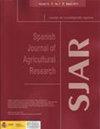The effect of corn grain micronization on diet digestibility and blood biochemical parameters in weaned Holstein calves
IF 0.8
4区 农林科学
Q3 AGRICULTURE, MULTIDISCIPLINARY
引用次数: 0
Abstract
Aim of study: To evaluate corn grain micronization for calves fed a grower diet. Area of study: Padinska Skela – Belgrade, Serbia. Material and methods: Thirty weaned Holstein dairy calves (65–74 days of age) were randomly assigned to one of two treatments with growers containing micronized (MCG) or untreated corn grain (UCG). The experimental period lasted for 60 days. Main results: The values of total tract apparent digestibility of dry matter (DM), organic matter (OM), crude protein (CP), and nonfiber carbohydrates (NFC) were higher for calves fed MCG versus those within the UCG treatment by 3.9% (p<0.05), 7.0% (p<0.01), 7.1% (p<0.01) and 7.5% (p<0.05), respectively, for the days 25–30 of the experimental period. In addition, the values of digestibility of OM, CP, and NFC were higher by 4.9% (p<0.05), 5.7% (p<0.05), and 6.0% (p<0.05), respectively, for the days 55–60 of the experimental period. The density of metabolizable energy, net energy for maintenance and gain in consumed dietary DM was higher (p<0.001) by 4.7, 5.5, and 7.2%, respectively for calves fed on the grower containing micronized corn grain (MCG), during the first digestibility period, and by 3.0, 3.6, and 4.6%, respectively, during the second digestibility period. Energy intake was lower (p<0.05) during the second digestibility period, for calves fed a diet with micronized corn. Blood urea N was affected (p<0.001) by dietary treatments. Lower values (10.2%) were observed for calves fed the grower containing MCG. Research highlights: The micronization of corn grain is a useful tool for optimizing weaned calf production due to the improvement in the digestibility and energy content of the ration.玉米颗粒微粉化对荷斯坦断奶小牛日粮消化率和血液生化参数的影响
研究目的:评价生长犊牛日粮中玉米颗粒微粉化的效果。研究领域:帕丁斯卡斯卡拉-贝尔格莱德,塞尔维亚。材料与方法:选取30头断奶荷斯坦犊牛(65 ~ 74日龄),随机分为两组,分别饲喂微粉玉米(MCG)和未处理玉米(UCG)。试验期60 d。主要结果:试验期25 ~ 30 d, MCG组犊牛干物质(DM)、有机物(OM)、粗蛋白质(CP)和非纤维性碳水化合物(NFC)的全消化道表观消化率分别比UCG组高3.9% (p<0.05)、7.0% (p<0.01)、7.1% (p<0.01)和7.5% (p<0.05)。试验第55 ~ 60天OM、CP和NFC的消化率分别提高了4.9% (p<0.05)、5.7% (p<0.05)和6.0% (p<0.05)。饲粮中添加微粉玉米颗粒(MCG)的犊牛代谢能密度、维持净能密度和增重净能密度在第一消化期分别提高了4.7%、5.5%和7.2% (p<0.001),在第二消化期分别提高了3.0、3.6%和4.6% (p<0.001)。在第二消化期,玉米粒化饲粮的能量摄入量较低(p<0.05)。饮食处理对血尿素N有影响(p<0.001)。在含有MCG的培养基中喂养的犊牛,观察到较低的数值(10.2%)。研究重点:玉米颗粒微细化可提高日粮的消化率和能量含量,是优化断奶犊牛产量的有效工具。
本文章由计算机程序翻译,如有差异,请以英文原文为准。
求助全文
约1分钟内获得全文
求助全文
来源期刊

Spanish Journal of Agricultural Research
农林科学-农业综合
CiteScore
2.00
自引率
0.00%
发文量
60
审稿时长
6 months
期刊介绍:
The Spanish Journal of Agricultural Research (SJAR) is a quarterly international journal that accepts research articles, reviews and short communications of content related to agriculture. Research articles and short communications must report original work not previously published in any language and not under consideration for publication elsewhere.
The main aim of SJAR is to publish papers that report research findings on the following topics: agricultural economics; agricultural engineering; agricultural environment and ecology; animal breeding, genetics and reproduction; animal health and welfare; animal production; plant breeding, genetics and genetic resources; plant physiology; plant production (field and horticultural crops); plant protection; soil science; and water management.
 求助内容:
求助内容: 应助结果提醒方式:
应助结果提醒方式:


